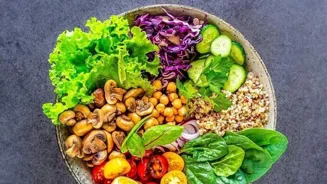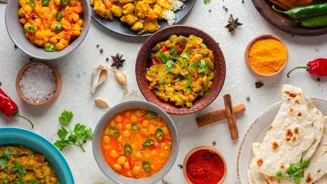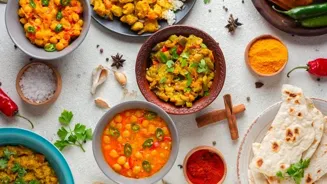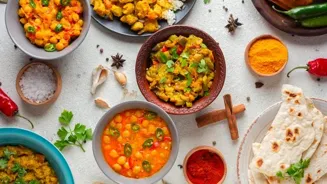Discover the art of using seasonal ingredients in Indian cooking! Embrace nature's bounty for flavorful meals. Read more!
Indian cuisine, a vibrant tapestry of flavors and aromas, is deeply rooted in the
land and its seasons. Traditionally, Indian cooking has always emphasized the use of fresh, locally sourced ingredients.
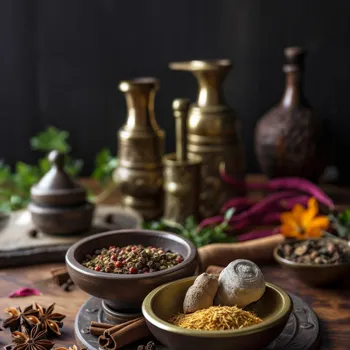
Following this philosophy not only enhances the taste of your dishes but also contributes to a healthier lifestyle and supports local farmers. Incorporating seasonal produce into your Indian recipes is a beautiful way to connect with nature's rhythm and unlock a world of culinary possibilities.
India's diverse climate allows for a wide array of fruits and vegetables to flourish at different times of the year. Adapting your cooking to embrace these seasonal treasures will bring a new dimension to your everyday meals.
Seasonal ingredients offer freshness, flavor, nutrients, and sustainability in cooking
One of the greatest advantages of using seasonal ingredients is the unparalleled freshness and flavor they offer. Produce that is harvested at its peak ripeness is bursting with natural sweetness, vibrant color, and a higher concentration of nutrients.
This translates into dishes that are more flavorful and satisfying. When you buy locally grown, seasonal produce, you are also supporting your local farming community. This fosters a sustainable food system and reduces the carbon footprint associated with transporting food over long distances.
Additionally, seasonal ingredients tend to be more affordable, making them a budget-friendly option for home cooks. Embracing seasonal cooking encourages creativity in the kitchen.
Summer in India is all about mangoes and refreshing recipes using seasonal produce
Summer in India is synonymous with mangoes! This "king of fruits" can be used in countless ways, from simple mango lassi and aamras to more elaborate desserts like mango shrikhand or mango phirni.
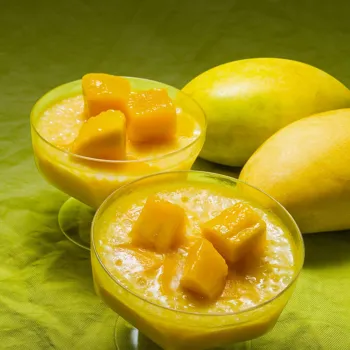
Don't limit yourself to just desserts; unripe green mangoes (kairi) can be used to make tangy chutneys, pickles, and cooling drinks like aam panna.
Summer also brings an abundance of cucumbers, which are perfect for refreshing salads, raitas, and even adding a crunchy element to your stuffed parathas.
Other summer vegetables like gourds (lauki, tori) and okra (bhindi) can be transformed into flavorful curries and stir-fries with the right blend of spices. Remember to stay hydrated by incorporating cooling ingredients like yogurt, mint, and coconut water into your summer recipes.
Summer squash curries & refreshing salads elevate seasonal flavors
Consider adding summer squash variations in form of flavorful curries. Spices such as cumin, coriander, and turmeric complement the natural sweetness of the squash, creating a harmonious and satisfying dish. To elevate the dish the squash is roasted that brings out the natural sugars and sweetness.
Summer encourages eating light so salads are the best way to enjoy the seasonal flavors. Combining fresh mint, coriander, and green chillies mixed with finely chopped cucumber and tomatoes creates a burst of freshness. A squeeze of lemon juice enhances the flavours and adds acidity to the salad.
Enjoy sweet mangoes and use them in many forms of foods or drinks.
Monsoon treats like bhutta, jackfruit, and patra are popular
The monsoon season brings with it a unique set of ingredients. Corn on the cob (bhutta) is a quintessential monsoon treat, enjoyed grilled with a sprinkle of lemon and chili powder. Jackfruit, both ripe and unripe, is another versatile ingredient.
Unripe jackfruit (kathal) can be cooked as a vegetable and used in curries, while ripe jackfruit can be enjoyed as a fruit or used in desserts. Colocasia leaves (arbi ke patte) are used to make delicious patra, a steamed and rolled snack that is both healthy and flavorful.
It is important to clean the leaves thoroughly before using them and to apply tamarind paste or lemon juice to prevent any itching sensation in the throat.
Abundance of bitter gourd & spinach in monsoon, ginger, garlic tradition in Indian cuisine
Bitter gourd and spinach become more abundant, although the heavy rain may hinder growth of produce. During this time it is important to clean the product before use. Ginger and garlic come to our rescue during Monsoon. Adding garlic and ginger in Indian recipes is a tradition.
They are known for the medicinal properties. Turmeric adds a wonderful flavor to dish, it also cleanses the blood. Monsoon means pakoras and samosas with tea. Instead of going the regular way, seasonal veggies can be added inside.
Winter in India offers abundance of root veggies & leafy greens for versatile dishes
Winter is a season of abundance in India, with a wide variety of root vegetables and leafy greens readily available. Carrots, beets, and sweet potatoes are naturally sweet and can be used in both savory and sweet dishes.
Gajar ka halwa (carrot pudding) is a popular winter dessert, while aloo gobi (potato and cauliflower curry) is a classic savory preparation. Leafy greens like spinach, fenugreek (methi), and mustard greens (sarson) are packed with nutrients and can be used in saags, stir-fries, and parathas.
Radishes (mooli) add a peppery bite to salads and raitas. Remember to use sesame oil and warming spices like ginger, garlic, and black pepper to create dishes that are both comforting and nourishing during the colder months.
Winter foods: gooseberries, pickles, veggies, ginger, garlic for health
Indian gooseberries also come during winter which are a great source of vitamin C. They can be used as pickles, murabbas and chutney. Radish, carrot, and ginger are useful vegetables that can be pickled. Cauliflower is best during winters.
Methi aloo and palak paneer are also very important during the winter. A lot of green veggies grow during the winter. You should add garlic, ginger, and black pepper when the weather is cooler. This will keep you healthy and add heat to your body.
Spring brings fresh herbs, tender veggies for vibrant dishes
Spring is a time of renewal and rebirth, and the culinary scene is no exception. This season brings a new wave of fresh herbs and tender vegetables. Mint, coriander, and dill are abundant and can be used to add a burst of flavor to chutneys, raitas, and salads.
Spring onions, peas, and green beans are at their sweetest and most tender. Use them in stir-fries, curries, and even as a filling for samosas. Spring is also a great time to experiment with edible flowers like pansies and nasturtiums, which can add a touch of beauty and elegance to your dishes.
Lightly spiced vegetable pulaos and khichdis are perfect for the warmer weather.
Spring cooking: light meals, fresh veggies, balanced spices, quick with pressure cooker
As the weather warms up, salads and light meals are the right choice. Lightly spiced and using spring vegetables makes for a great experience. Adding green beans and peas can add a flavor to the dish.
When cooking during spring it is important to keep the spices balanced, avoid heavy oil based foods. During spring you feel awake and energetic and cooking fresh food is a great option. Using a pressure cooker reduces time and effort
Meal planning around seasonal produce from local markets
Plan your meals around what's in season. Visit your local farmers market or grocery store to see what's fresh and abundant.

Flexibility in recipes: Substitute ingredients as needed
Be flexible with your recipes. Don't be afraid to substitute ingredients based on what's available.
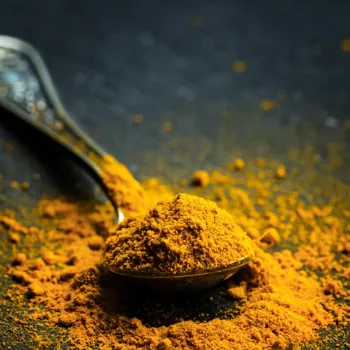
Discover regional produce for informed shopping and cooking
Learn about the local produce of your region. This will help you make informed decisions about what to buy and how to cook it.
Preserve produce with pickling, drying, freezing
Preserve seasonal produce for later use. Pickling, drying, and freezing are great ways to extend the life of your favorite ingredients.
Exploring new recipes and seasonal flavors
Experiment with new recipes and flavor combinations. Seasonal cooking is a journey of discovery!
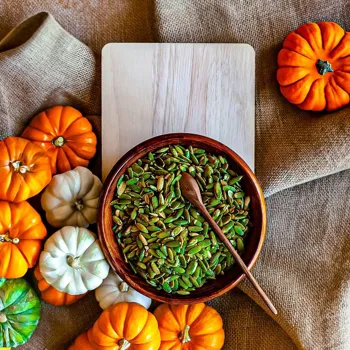
Seasonal cooking supports health, local businesses, and creativity
Seasonal cooking is about listening to nature and eating right! The goal to eat healthy and support local businesses. By consuming those products you are helping local businesses. The more you explore, the more you will understand. You will have access to fresh flavors and nutrients.
By following this method you will have a creative and delicious experience. Food is very important and you should respect it along with enjoying it!
AI Generated Content. Glance/InMobi shall have no liability for the content



